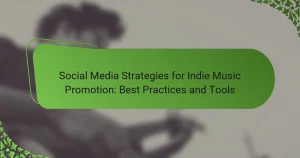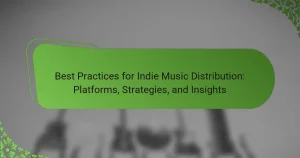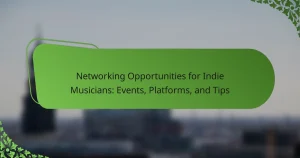Crowdfunding empowers indie bands to secure financial support while engaging directly with their fan base. This article explores key platforms like Kickstarter and Indiegogo, highlights successful case studies, and offers practical tips for launching effective campaigns. Understanding the challenges and unique attributes that enhance a band’s appeal is crucial for achieving funding goals and fostering community connections.
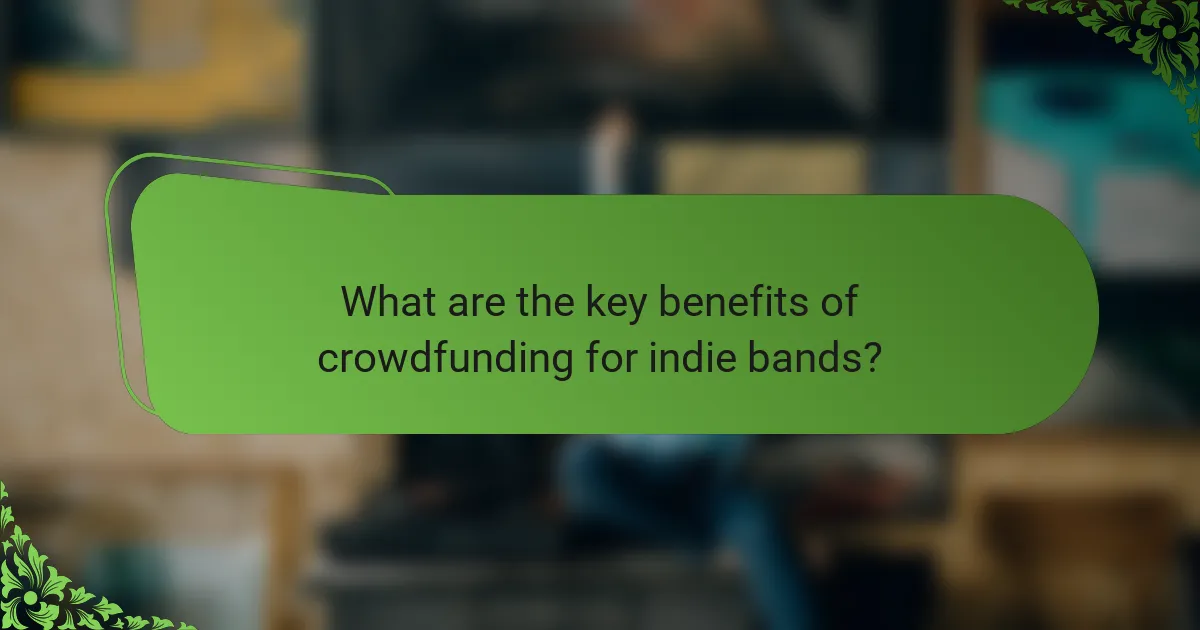
What are the key benefits of crowdfunding for indie bands?
Crowdfunding offers indie bands essential benefits, including financial support, community engagement, and increased visibility. It allows artists to raise funds directly from fans, bypassing traditional funding routes. Successful campaigns can foster loyal fan bases and generate buzz around new projects. Additionally, platforms like Kickstarter and Indiegogo provide tools for marketing and outreach, enhancing the chances of success.
How does crowdfunding help in music production?
Crowdfunding significantly aids music production by providing indie bands with financial support directly from fans. This model allows artists to fund albums, music videos, and tours while building a loyal community. Successful platforms like Kickstarter and Indiegogo have enabled numerous bands to achieve their goals, often exceeding funding targets. Additionally, engaging with fans through exclusive rewards enhances the overall experience, fostering a deeper connection.
Why is fan engagement crucial for funding success?
Fan engagement is essential for funding success as it builds a loyal supporter base. Engaged fans are more likely to contribute financially to crowdfunding campaigns, ensuring higher funding levels. Successful indie bands often leverage their fan relationships to create compelling campaigns, increasing visibility and trust. For instance, bands that share exclusive content or personal stories foster deeper connections, resulting in stronger financial backing.
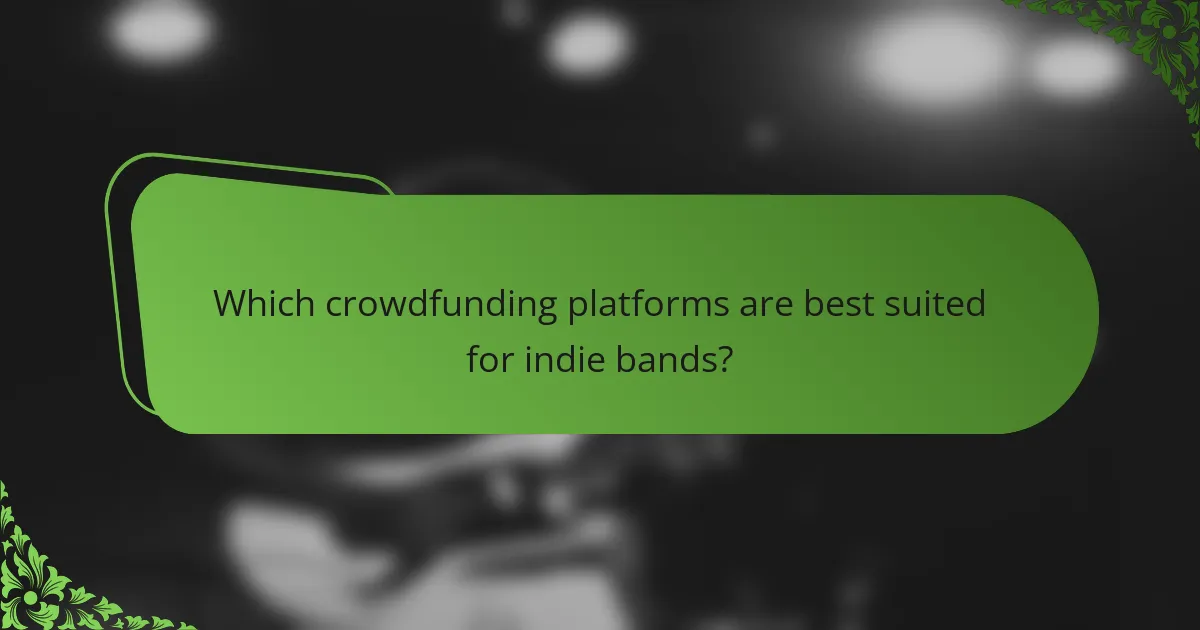
Which crowdfunding platforms are best suited for indie bands?
Kickstarter and Indiegogo are the best crowdfunding platforms for indie bands due to their wide reach and supportive communities. Kickstarter offers an all-or-nothing funding model, which encourages backers to contribute fully. Indiegogo provides flexible funding options, allowing bands to keep what they raise. Both platforms have successful case studies showcasing indie bands that achieved their funding goals. Additionally, platforms like Patreon enable ongoing support through subscriptions, fostering a loyal fanbase.
What features should you look for in a crowdfunding platform?
Look for user-friendly interfaces, flexible funding options, strong community support, transparent fee structures, and effective marketing tools in a crowdfunding platform. These features enhance campaign success for indie bands.
How do regional platforms differ in their offerings?
Regional crowdfunding platforms for indie bands vary in their features, target audiences, and funding models. Some focus on local artists, while others cater to a global audience. For instance, platforms like Kickstarter emphasize project-based funding, whereas Indiegogo allows flexible funding options. Additionally, some platforms offer promotional tools and community engagement features to enhance visibility. Each platform’s unique attributes can significantly impact a band’s success, depending on their specific needs and goals.

What are some successful crowdfunding campaigns by indie bands?
Successful crowdfunding campaigns by indie bands often leverage platforms like Kickstarter and Indiegogo to connect with fans. Notable examples include Amanda Palmer, who raised over $1.2 million, showcasing the potential of direct fan engagement. Another success story is the band The Ongoing Concept, which raised $80,000 for their album, highlighting effective marketing strategies. These campaigns emphasize the importance of storytelling and community building, enabling indie bands to achieve financial goals while fostering loyal fanbases.
What strategies contributed to their success?
Successful crowdfunding for indie bands relies on engaging storytelling, effective marketing strategies, and building a loyal fanbase. Bands that share personal journeys create emotional connections, driving support. Utilizing social media platforms amplifies reach, while offering exclusive rewards incentivizes contributions. Collaborating with influencers can expand visibility, enhancing campaign success.
How did these bands leverage social media?
Indie bands leverage social media to build fan engagement, promote crowdfunding campaigns, and share music. They utilize platforms like Instagram and Twitter for real-time interaction, creating a sense of community. Success stories include bands that raised significant funds through targeted campaigns, often using engaging content to attract backers. Effective strategies involve regular updates, behind-the-scenes content, and direct communication with supporters.

What challenges do indie bands face when crowdfunding?
Indie bands face several challenges when crowdfunding, including limited audience reach, competition with established artists, and the need for effective marketing strategies. Additionally, they often struggle with setting realistic funding goals and managing backer expectations. Financial transparency and communication are crucial to maintaining trust with supporters.
How can bands overcome common pitfalls?
Indie bands can overcome common pitfalls by focusing on clear communication, setting realistic goals, and engaging their audience effectively. Transparency in budgeting and project timelines builds trust. Utilizing social media for updates fosters community involvement. Learning from successful crowdfunding campaigns provides valuable insights.
What legal considerations should be taken into account?
Crowdfunding for indie bands involves various legal considerations. Firstly, ensure compliance with local securities laws, as some crowdfunding models may classify contributions as investments. Secondly, protect intellectual property by securing rights to music and branding before launching a campaign. Thirdly, clearly outline terms and conditions for backers, including rewards and obligations. Lastly, be aware of taxation implications, as funds raised may be subject to income tax.
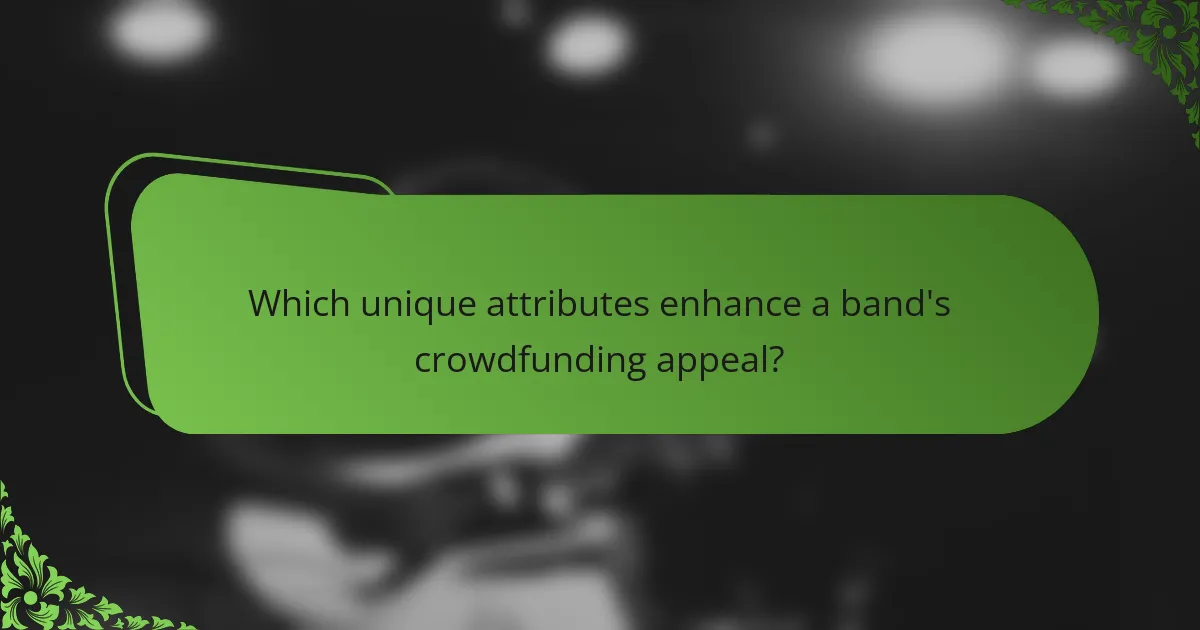
Which unique attributes enhance a band’s crowdfunding appeal?
Unique attributes that enhance a band’s crowdfunding appeal include strong fan engagement, compelling storytelling, and unique rewards. These factors create emotional connections and differentiate campaigns. Successful bands often showcase their authenticity and personal journeys, making them relatable. Additionally, leveraging social media presence amplifies reach and attracts diverse backers.
How does a band’s genre influence funding success?
A band’s genre significantly influences its crowdfunding success by shaping audience expectations and engagement. Genres with established fan bases, like rock or hip-hop, often attract more funding due to loyal supporters. In contrast, niche genres may struggle despite unique offerings. Successful campaigns frequently leverage genre-specific marketing strategies to connect with potential backers. For example, indie folk bands often emphasize storytelling, appealing to fans’ emotions. Overall, aligning genre characteristics with funding tactics enhances the likelihood of achieving financial goals.
What role does branding play in attracting backers?
Branding is crucial for attracting backers, as it creates a recognizable identity and builds trust. A strong brand communicates professionalism and passion, which resonates with potential supporters. For indie bands, effective branding can differentiate them in a crowded market, showcasing their unique sound and story. Engaging visuals and consistent messaging enhance emotional connections, encouraging backers to invest in their journey.

What are the latest trends in crowdfunding for indie music?
Crowdfunding for indie music is increasingly focused on community engagement and unique storytelling. Platforms like Kickstarter and Indiegogo are popular, enabling artists to connect directly with fans. Successful campaigns often feature compelling narratives, exclusive rewards, and social media promotion. Notable success stories include Amanda Palmer, who raised over $1.2 million, demonstrating the potential of crowdfunding in the indie music scene. Tips for success include setting realistic funding goals, offering diverse reward tiers, and maintaining communication with backers throughout the campaign.
How has the COVID-19 pandemic affected crowdfunding strategies?
The COVID-19 pandemic has significantly shifted crowdfunding strategies for indie bands. Many artists have turned to online platforms like Kickstarter and Indiegogo to connect with fans and raise funds directly.
During the pandemic, artists faced challenges like canceled tours and reduced income. As a result, successful campaigns often emphasized community support and engagement. For example, bands offered exclusive content or virtual experiences to incentivize contributions.
The shift to digital promotion has also increased competition. Indie bands must now craft compelling narratives and utilize social media effectively to stand out. This adaptation is crucial for success in a crowded online space.
Overall, the pandemic has transformed crowdfunding into a more interactive and community-driven process, enabling indie bands to thrive despite external challenges.
What innovative approaches are emerging in 2025?
Innovative approaches in 2025 include specialized crowdfunding platforms for indie bands, leveraging social media integration, and community-driven funding models. These platforms enhance visibility and engagement, leading to successful campaigns. Notable success stories highlight bands achieving funding goals through unique marketing strategies and fan involvement. Tips for success include setting clear funding goals, offering exclusive rewards, and maintaining transparent communication with backers.
What are the best practices for running a successful campaign?
To run a successful crowdfunding campaign for indie bands, focus on engaging storytelling and building a community. Start by selecting the right platform that aligns with your goals and audience. Promote your campaign through social media and email to maximize reach. Offer appealing rewards that resonate with backers, and maintain regular updates to keep supporters informed. Successful examples show that personal connections and authenticity drive funding.
What common mistakes should bands avoid during crowdfunding?
Indie bands should avoid common mistakes like insufficient planning, lack of engagement with fans, and unrealistic funding goals. These errors can hinder crowdfunding success.
1. Insufficient Planning: Failing to outline a clear strategy can lead to confusion and missed opportunities.
2. Lack of Engagement: Not actively communicating with backers can result in diminished interest and support.
3. Unrealistic Funding Goals: Setting goals that are too high or too low can deter potential backers.
4. Ignoring Marketing: Neglecting to promote the campaign limits visibility and potential contributions.
5. Poor Presentation: A lackluster campaign page can fail to attract attention and convey professionalism.
6. Inadequate Rewards: Offering unappealing or poorly thought-out rewards can reduce incentive for backers.
